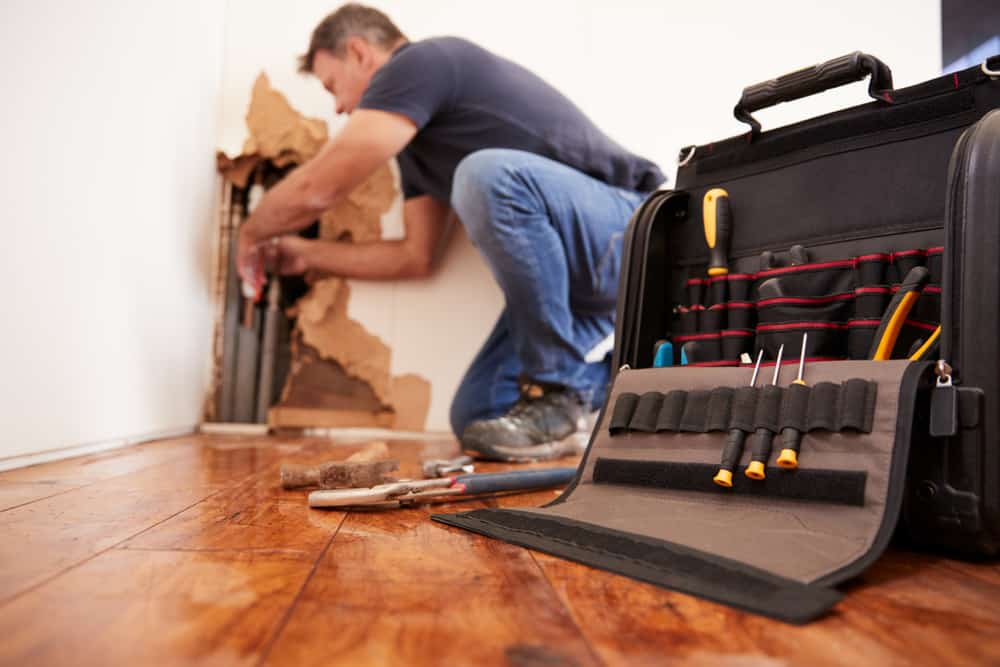Water Damage due to Household Appliances
Imagine coming home from a long day of work to find that the dishwasher you had started in the morning had somehow sprung a leak during the cycle. Your hardwood floors are covered in water. Soaked. You can already see discoloration and warping beginning to take effect. Water damage due to household appliances was not something that you had prepared for.
How long has the water been leaking? How do I clean this up? Does my insurance cover this? Does the flooring need replaced?
These thoughts, plus plenty more, might start running through your brain. You rush to the closet, grasping for towels. Anxiety may spring up as the prospect of contacting multiple companies, coordinating restoration efforts with your already hectic schedule, seems nearly impossible to manage.
That’s where we come into play, at 1-800 Water Damage of Western Colorado. If your hardwood floors are ruined from your leaking dishwasher, we can save you the time and headache of contacting multiple contractors. Our team is trained to extract water, dry out flood damage, removal any necessary material, and get you the contents cleaning and reconstruction services you need, alongside.
Full Water Restoration
The distinction between a water mitigation company and a water restoration company is substantial. Water mitigation companies are simply concerned with mitigating or preventing any further damage. Those companies look to stop the source of water damage, and get your personal belongings to a space where they won’t be damaged. Water mitigation companies do not concern themselves with restoring your home or workspace to its original condition. 1-800 Water Damage, however, focuses not only on the initial water mitigation, but we are concerned with helping you restore your space so that there aren’t any traces that water damage ever occurred.
Insurance and Water Damage
When you live in a land-locked area like we do, in Grand Junction, water damage isn’t something that the average person plans for. The reality is, though, that 1 in every 50 insured homes, each year, has a water damage claim. In fact, it’s the second most reported insurance claim, behind wind and hail damage. If you have a basement, well, be prepared, because statistics show that 98% of people who own property that includes a basement experience water damage at some point. As such, it’s important to ensure that you have proper insurance as a homeowner (or renter) in order to prepare for potential household hazards.
Appliances Most Likely to Cause Water Damage
We’ve already determined that when it comes to water damage in Grand Junction, it’s not just outside water sources that are of concern, but that oftentimes your household appliances can be to blame. You may wonder which appliances pose the greatest risk. Let’s take a look at the top five appliances most likely to cause water damage in your home:
Water Heater
- The older your water heater, the more like it is to fail. If your water heater is over 11 years old, chances are high that it will not remain in working condition for long.
- The average cost to repair damage from water heater failure is over $4,000.
- Leaks or bursts (yikes!) in your water heater account for the majority of problems associated with them.
- We recommend that you flush your water heater once every 6 months. This helps rid your water heater of any sediment build up that has occurred at the base of your tank.
Air Conditioner
- Attic-placed air conditioners (including swamp coolers) result in the most substantial water damage in a home because the water is able to flow throughout the entire household.
- $5000 is roughly the amount of damage incurred from flooding due to a malfunction in your air conditioner or swamp cooler unit.
- Experts recommend installing a drainpipe on your air conditioning unit so that accumulating water is guided away from the house. Similarly, swamp cooler lines can be ran on the outside of a home.
- As always, ensure that a professional connects and disconnects your unit each season.
-
Washing Machine
- The majority of washing machine leaks are a result of faulty hoses.
- Typically, younger machines are more likely to have hose failures.
- It’s important to replace hoses every 5 years and to check hoses and fixtures for signs of wear and tear.
- Washing machines in houses that are vacant are 6 times more likely to result in water damage. Ensure that you switch off the water source to your machine if you plan on being away from your home for an extended period of time. It’s also a good idea, if your house is vacant, to have someone check on it routinely to ensure that everything is safe.
-
Refrigerator
- Defrost drains that freeze or clog result in the most water damage from a refrigerator.
- Leaky ice makers are also common culprits.
-
Dishwasher
- Dishwasher leaks most often occur from faulty hose connections, valves, or switches.
- Ever heard that you shouldn’t add too much detergent to the cycle? Well, the reasoning behind this is, is that if you don’t, a puddle of water can collect at the base of your dishwasher.
- You may need to replace dishwashers that are over 10 years old, as a preventative measure. It’s always a good idea to have an appliance maintenance company check your appliances for routine preventative maintenance.
-
Contact a Professional
If you find yourself in the precarious position of experiencing water damage, firsthand, contact us right away. We at 1-800 Water Damage know how valuable your time is. That’s why they are available 24/7 and have a guaranteed response time of two hours or less. Let’s be honest, when it comes to response, time is money.
Even a 1” pipe, if it bursts, can expel an average of 37 gallons per minute, and the average water heater holds 90 gallons of water. Personal safety is of course always the immediate concern when flooding or water damage is concerned, but people should also ensure that the long-term effects of water-damage are quelled before they take root— mold being the most obvious hazard you would want to prevent.



